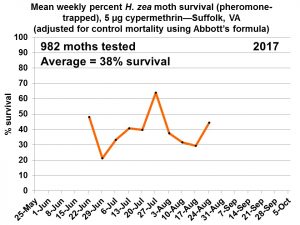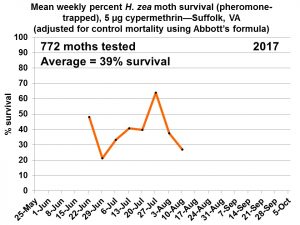The general FeXapan module is now available for online training for applicators in states that accept this method of training. Please see: http://www.dupont.com/products-and-services/crop-protection/soybean-protection/articles/fexapan-training.html
Author Archives: Sean Malone
2018 Mid-Atlantic Commercial Vegetable Production Recommendations
Posted on behalf of Dr. Ramón Arancibia:
The ‘2018 Mid-Atlantic Commercial Vegetable Production Recommendations’ has been posted in the VCE publication website and is available for printing. https://pubs.ext.vt.edu/456/456-420/456-420.html
Black light trap report for Sep. 28, 2017
Average nightly black light trap catches of corn earworm moths this week were: Southampton=0.3; Prince George (Templeton)=6; Prince George (Disputanta)=4; Hanover=2; Suffolk=26. Here is the data table: BLT_28_Sep_2017
Most traps are being stowed now. We greatly appreciate the reports this season from Watson Lawrence (Chesapeake); Mike Parrish and Angela Duncan (Dinwiddie); Laura Maxey-Nay (Hanover); Scott Reiter (Prince George); Mary Beahm (Warsaw); LIvvy Preisser (Southampton); and Sally Taylor and her entomology team (Suffolk). We also want to thank the growers who hosted the traps on their farms.
Black light trap report for Sep. 21, 2017
Average nightly captures of corn earworm moths in area black light traps were as follows: Suffolk=8; Southampton=1; Warsaw=20; Prince George (Templeton)=10; Prince George (Disputanta)=5. There were no reports of any brown marmorated stink bugs caught in the black light traps this week. Here is the corn earworm data table: BLT_21_Sep_2017
Insect update for Sep. 7, 2017
Most reporting black light trap stations this week had decreased corn earworm moth captures (except for Chesapeake remaining constant). Nightly averages were Chesapeake = 11; Southampton = 1; Suffolk = 8; and Warsaw = 4 moths. Here is the data table: BLT_7_Sep_2017
No brown marmorated stink bugs were caught this week in the black light traps.
Insect update for Aug. 31, 2017
This week, corn earworm (bollworm) moth captures in the black light trap were down at most locations (steady at Chesapeake and Prince George-Templeton), perhaps partly due to the rainy weather, but some “down” numbers are still pretty high (Suffolk, for example). The table is here: BLT_31_Aug_2017
We had no reports of any brown marmorated stink bugs captured in the black light traps this week.
We have vial-tested close to 1,000 corn earworm moths in Dr. Taylor’s pyrethroid resistance monitoring program in 2017, with an average of 38% survival.
Corn earworm black light trap report for August 24, 2017
NIghtly trap averages for corn earworm moths had a wide range this week–please see the attached pdf file for your most local data: CEW_24_Aug
Insect update for Aug. 17, 2017
Corn earworm moth captures in the black light traps ranged from 2 to 45 moths per night; brown marmorated stink bug catches ranged from zero to 2.6 per night. Here are the data tables: BLT_17_Aug_2017
In our corn earworm (bollworm) vial tests, we are averaging 39% moth survival, with 832 moths tested to date.
Insect update for Aug. 10, 2017
Black light trap captures of corn earworm/bollworm ranged from 5 to 78 moths per night this week. Brown marmorated stink bug captures ranged from zero to 2 per night. Here are the data tables: BLT_10_Aug_2017
Resistance monitoring of corn earworm/bollworm shows that this season in Suffolk, an average of 39% of moths survived the 24-hour exposure period to the pyrethroid, cypermethrin.
Results of the 2017 field corn survey for corn earworm
The attached pdf file is a summary of Dr. Sally Taylor’s corn earworm survey in field corn; it is useful in predicting the corn earworm pressure in other crops such as soybean, cotton, and peanut as moths emerge from the corn. There are many folks to acknowledge this year (also included in the pdf file). Please see: CEW_survey_results_2017

